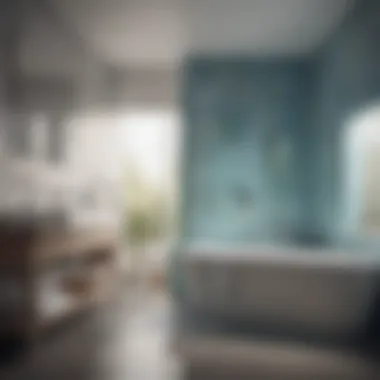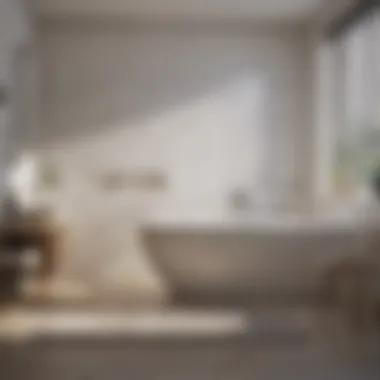Understanding Water Clogging in Bathrooms: Causes and Solutions


Intro
Water clogging in bathrooms is a common yet often underestimated issue for homeowners. It can lead to inconveniences ranging from mild delays in drainage to significant property damage if left unaddressed. This problem typically arises from a combination of factors, including poor plumbing design, accumulated debris, and inadequate maintenance practices. As bathrooms are crucial areas within a home, understanding the root causes and implementing effective solutions is vital for maintaining both functionality and aesthetic appeal.
This article provides a detailed exploration of the mechanisms behind water clogging, highlighting potential triggers and discussing practical approaches for resolution. Furthermore, we will address preventative measures that homeowners can undertake to prolong the integrity of their bathroom facilities. Timely intervention is paramount in preventing irreversible damage and ensuring a comfortable living space for all residents.
Feature Spotlight
In understanding water clogging, it is essential to note the relationship between the design of bathroom features and their efficiency in handling water flow. Optimally designed plumbing layouts can significantly reduce the risk of clogs.
Exceptional Architectural Designs
Good architectural design plays a key role in aiding proper drainage. Utilizing modern plumbing systems that promote optimal water flow helps mitigate risks associated with clogging. Features to consider include:
- Strategically placed drainage points that facilitate quick water dispersal.
- Sloped floor designs that prevent water collection in undesired areas.
- Efficient installation of fixtures, such as sinks and shower drains, which comply with industry standards.
Unique Decor Elements
While aesthetics are important, they should not compromise functionality. Certain decor elements may inadvertently contribute to water clogging. For instance:
- Heavy draperies can trap moisture, leading to mold and mildew.
- Decorative bathroom rugs may hinder water flow if poorly placed.
- Large potted plants, while visually appealing, might lead to excessive watering in confined spaces.
By combining good design with attentive maintenance, homeowners can significantly decrease the chances of water clogging in their bathrooms, thus sustaining a functional and beautiful home environment.
Causes of Water Clogging
Understanding the causes of water clogging is crucial in formulating preventative strategies. Clogging can arise from a few primary factors:
- Accumulation of debris: Hair, soap scum, and product residues often gather in drains, creating blockages.
- Faulty plumbing design: Improperly designed systems may not allow sufficient water flow, resulting in backups.
- Tree roots intrusion: In older homes, tree roots can invade sewer lines, obstructing water flow.
- Inadequate ventilation: Insufficient airflow can cause pressure issues in plumbing, leading to stagnation.
Recognizing these factors can help homeowners stay vigilant.
Solutions to Address Clogging
When issues arise, knowing how to respond is essential. Consider implementing the following solutions:
- Regular maintenance: Clean drains monthly using natural solutions like vinegar and baking soda to prevent buildup.
- Professional inspections: Schedule periodic plumbing checks to identify potential problems early on.
- Install drain covers: These can catch debris and prevent it from entering the plumbing system.
- Educate household members: Inform everyone about what should and should not go down the drains.
Adopting these measures can lead to long-term benefits, safeguarding your bathroom’s functionality.
Ending
Water clogging in bathrooms is a multifaceted issue that warrants attention. By grasping its causes, recognizing the importance of proper design, and implementing solutions, homeowners can maintain both the functionality and aesthetic appeal of their bathrooms. Ignoring this issue can result in greater complications and expenses.
"Timely intervention can prevent irreversible damage and ensure a comfortable living space."
For further reading on plumbing solutions and maintenance, you may visit these resources: Wikipedia, Britannica, Reddit.
It is essential to prioritize proactive measures in ensuring a clean and usable bathroom for years to come.
Prelude to Bathroom Water Clogging
Water clogging in bathrooms is a problem that can disrupt daily routines and lead to significant property damage if not managed promptly. Understanding this issue is crucial for homeowners and real estate enthusiasts alike. A bathroom that experiences regular water clogging not only becomes inconvenient but can also result in costly repairs. Therefore, early detection and intervention become essential.
In this article, we will explore what water clogging means, identify common causes behind it, and discuss effective solutions. Recognizing the signs of clogging early can significantly reduce the risk of major plumbing issues. This section aims to inform readers about foundational concepts regarding bathroom water clogging, setting the stage for a deeper analysis in subsequent sections.


Definition of Water Clogging
Water clogging refers to the accumulation of water in a designated drainage area that fails to flow freely. This problem usually arises in sinks, showers, and bathtubs when water cannot exit due to blockages in the pipes. Blockages can occur from various sources, such as hair, soap residue, foreign objects, or even issues related to plumbing infrastructure.
When water clogging occurs, it can lead to standing water that might produce unpleasant odors and create unsanitary conditions. Moreover, prolonged clogging can result in the degradation of pipe integrity, as trapped water can lead to corrosion or mold development over time.
Common Signs of Clogging
There are several warning signs that can indicate a potential clog in the bathroom. Recognizing these early can help you intervene before a minor issue escalates into a major problem. Common signs include:
- Slow Draining: If water takes an unusually long time to drain, it may indicate an emerging clog.
- Gurgling Noises: Unusual sounds emanating from the drain can hint at trapped air trying to escape around the blockage.
- Unpleasant Odors: Bad smells can emerge from stagnant water that is not moving through the pipes.
- Visible Debris: If you can see hair or other debris in the drain, it suggests a buildup that could lead to water clogging.
Being aware of these signs can empower homeowners to act quickly, preserving both functionality and aesthetics in their bathroom spaces. It is essential to prioritize bathroom maintenance to avoid the negative implications associated with water clogging.
"An ounce of prevention is worth a pound of cure."
By addressing minor issues efficiently, homeowners can greatly improve their quality of living and the longevity of their plumbing systems.
Analyzing the Causes of Water Clogging
Examining the reasons behind water clogging in bathrooms is crucial for homeowners. Identifying the underlying causes effectively reduces the chance of reoccurring issues. This section explores several specific factors contributing to water clogging, allowing for a better understanding of how to handle and prevent such situations in the future.
Hair and Debris Accumulation
Hair is one of the most common culprits of clogged drains in bathrooms. When hair mixes with other debris such as soap residues and skin cells, it creates a thick mass that obstructs water flow. The shower stall and sink are particularly vulnerable to this issue. Regularly removing hair clumps from drain openings can reduce the chances of blockage. Additionally, using drain covers can capture hair before entering the plumbing system, thus acting as a barrier to prevent build-up.
Soap Scum and Mineral Build-Up
Soap scum forms when soap combines with minerals found in water. This residue can accumulate on the inside of pipes, gradually reducing their diameter over time. Hard water, which contains high levels of calcium and magnesium, exacerbates this issue. Regular cleaning of bathtubs and sinks can remove soap scum, but it is also advisable to use vinegar or specialized cleaning agents to combat mineral deposits. The accumulation of soap scum not only leads to clogs but can also produce unpleasant odors in the bathroom.
Faulty Plumbing Systems
Sometimes the problem lies in the plumbing setup. Poorly designed or installed plumbing systems can lead to inconsistent water flow, creating areas where water stagnates. Old pipes may become corroded or dented, further limiting their efficiency. Regular inspections, especially in older homes, can catch these issues. Hiring a qualified plumber to evaluate the system can provide insights that might be overlooked by the average homeowner.
Tree Root Intrusion
In some cases, the problem can stem from outside the home. Tree root intrusion occurs when roots seek moisture and nutrients, often infiltrating sewer lines. This can lead to serious clogs and even pipe damage. Homeowners should keep trees a safe distance from plumbing lines and be attentive to any signs of drainage issues that suggest root growth. Professional services might be required to clear roots effectively without damaging the existing pipework.
Improper Waste Disposal
Many people dispose of waste products down drains that should not go there. Feminine hygiene products, cotton swabs, and similar items often lead to severe clogs. It's essential to educate household members on proper waste disposal methods. In bathrooms, a wastebasket should be easily accessible for disposal of such items. Maintaining awareness can significantly reduce the potential for clogs in the future.
Protecting your plumbing system not only saves money but also ensures the functionality of your bathroom, creating a comfortable living environment.
Evaluating the Impact of Water Clogging
Water clogging in bathrooms is more than an inconvenience; it can result in severe consequences if not addressed promptly. This section explores how water clogging affects structures and health, stressing why homeowners need to understand these implications. The presence of stagnant water often goes unnoticed until problems escalate.
Understanding the impact of water clogging is crucial for maintaining not just the functionality of a bathroom, but the overall health of a home. Acknowledging these effects empowers homeowners to take action before it's too late, thus preserving the aesthetics and utility of bathroom spaces.
Structural Damage Risks
One of the primary concerns associated with water clogging is the risk of structural damage. Unchecked water buildup can lead to deterioration of essential components within the bathroom and adjoining structures. Specifically:
- Water Leaks: Stagnant water can escape and infiltrate walls and floorboards, which may lead to mold growth and weakening of structural integrity.
- Foundation Compromise: Over time, excess moisture can affect the foundation of a house, prompting costly repairs and insurances issues.
- Damage to Fixtures: Water can corrode plumbing fixtures, which may necessitate frequent replacements, contributing to financial burdens.


These risks highlight the importance of early detection and resolution of any signs of clogging, including slow-draining sinks or discoloration around pipes.
"Ignoring water clogging issues may lead to extensive and expensive structural repairs later on."
Health Implications
Water clogging does not merely threaten the physical structure of a home; it poses significant health risks too. Stagnant water can become a breeding ground for various pathogens and pests, leading to several health complications. Key health concerns include:
- Mold and Mildew Growth: These fungi thrive in damp environments and can trigger various allergies and respiratory issues, particularly in sensitive individuals.
- Bacterial Infestations: Prolonged water stagnation can cultivate harmful bacteria, which can make people sick.
- Pest Attraction: Water accumulations attract unwanted pests, such as mosquitoes, which pose a threat of disease transmission.
In summary, evaluating the impact of water clogging is essential for informing effective responses and preventative measures. Homeowners must recognize both the structural and health-related ramifications that stem from this issue to ensure a secure and healthy living environment.
Short-term Solutions for Clogged Bathrooms
Water clogging can be a major inconvenience for any homeowner. Effective short-term solutions are essential for managing these issues promptly. Addressing clogs as soon as they appear not only saves time but also helps prevent more serious plumbing problems in the future. In this section, various techniques will be discussed which can alleviate clogs temporarily before opting for long-term fixes.
Plunger Techniques
A plunger is one of the most basic tools for a clogged toilet or drain. Knowing how to use it correctly can lead to a quick resolution. To start, ensure that the cup of the plunger covers the drain completely. Create a tight seal, then push down with force before pulling up sharply. This back-and-forth motion can create pressure that dislodges the clog. For toilets, it is best to use a flange plunger, which has an extended rubber part for better sealing.
Tips for Effective Use:
- Ensure the cup is submerged in water, as this makes it easier to create pressure.
- Avoid blocking overflow holes in the toilet if using it on a toilet.
- Keep trying for a few minutes; sometimes, persistence is key.
Using a Drain Snake
A drain snake is a more advanced tool for persistent clogs. Unlike a plunger, it can reach deeper into pipes. To use a drain snake, insert the end into the drain and gently push forward. When encountering resistance, turn the handle; this action helps to maneuver the snake around bends and break up the blockage. It is critical to pull the snake back slowly to avoid damaging the pipes.
Benefits of Using a Drain Snake:
- It can reach far into the plumbing system.
- Helps remove solidified debris that a plunger may not.
"A well-used drain snake can alleviate annoying clogs more effectively than repeated plunging."
Chemical Drain Cleaners
Chemical drain cleaners can be effective in situations where physical methods fail. They dissolve buildup and are suitable for minor to moderate clogs. However, they should be used cautiously due to potential harm to pipes and the environment. Always read the instructions and precautions carefully.
Factors to Consider When Using Chemical Cleaners:
- Only use them in well-ventilated areas to avoid inhaling fumes.
- Avoid mixing with other cleaners, as harmful reactions can occur.
- Consider eco-friendly alternatives if possible, to minimize environmental harm.
Long-term Prevention Strategies
Long-term prevention strategies are essential for mitigating the risk of water clogging in bathrooms. By adopting these strategies, homeowners can ensure their drainage systems function properly over time, reducing the likelihood of emergency repairs and costly damages.
Regular Drain Maintenance
Regular drain maintenance is a proactive step most homeowners can easily incorporate into their routines. This includes routine cleaning of the drains to remove debris, hair, and soap scum before they become significant blockages. Homeowners may consider using a mixture of baking soda and vinegar to help keep drains clear. This method is effective as it breaks down impurities without the harsh chemicals of some commercial cleaners. Regular inspections for dampness or unusual smells can also indicate problems before they escalate. Not only does regular maintenance enhance the lifespan of the plumbing system, but it also promotes a healthier living environment by reducing the risk of mold and bacteria growth.
Installing Drain Screens
Installing drain screens is another simple yet effective preventative measure against water clogging. Drain screens act as barriers that catch hair and debris before they can enter the drainage system. They are available in various materials and designs, allowing for customization based on personal preference and the bathroom's aesthetic. Selecting high-quality screens minimizes the chance of clogging, making them a wise investment. Additionally, cleaning these screens regularly guarantees they remain effective, further enhancing drain performance and reducing the necessity for extensive cleaning.


Routine Professional Inspections
Routine professional inspections are invaluable for identifying potential problems in the plumbing system that may go unnoticed by homeowners. Hiring a qualified plumber to conduct periodic checks helps in early detection of issues such as tree root intrusions or deteriorating pipes. These professionals have the tools and expertise to assess the condition of the piping infrastructure thoroughly. Regular inspections not only extend the life of the plumbing system but also provide peace of mind.
Investing in professional inspections can help prevent significant water damage later.
When to Call a Professional
Water clogging in bathrooms can be a common issue, but there are instances where resolving the problem requires the expertise of a professional. While minor clogs might be handled through DIY methods, significant blockages or recurring issues often signal a deeper problem. Knowing when to call a professional plumber is essential for maintaining the integrity of your bathroom and ensuring the functionality of your plumbing system.
Signs That Indicate Immediate Action is Required
Several indications suggest that immediate professional action is necessary. If you notice any of the following signs, it is prudent to consider reaching out to an expert:
- Persistent Clogs: If your drains frequently become clogged despite regular maintenance, it could indicate a larger issue within the plumbing.
- Foul Odors: Unpleasant smells can signify stagnant water or decaying matters in the pipes, which often require professional cleaning.
- Slow Drainage: Gradual draining can suggest a blockage deeper in the system that may not be accessible with basic tools.
- Multiple Fixtures Affected: If the clog impacts several sinks or toilets, there may be a central issue in the plumbing.
- Visible Leakage: Any signs of leaking around fixtures or pipes means it is essential to have a professional assess the situation fully.
- Unexplained Water Accumulation: Puddles or wet spots on the bathroom floor can indicate a hidden leak.
"These signs should not be ignored; addressing them swiftly can save homeowners from costly repairs later on."
Choosing the Right Plumbing Service
Selecting a qualified plumbing service is crucial when facing water clogging issues. Here are key considerations to ensure you make an informed choice:
- Credentials and Licenses: Verify that the plumber holds the necessary certifications and licenses to operate in your area. This indicates a level of professionalism and adherence to local regulations.
- Experience with Similar Issues: Look for a service that has experience specifically with bathroom drainage problems. Their familiarity with common clogging causes can lead to quicker and more effective solutions.
- Online Reviews and Recommendations: Assess feedback from previous customers online. Platforms like Reddit or dedicated plumbing review sites can provide valuable insights on the reliability of various services.
- Transparent Pricing: Ensure the plumbing service provides clear estimates before beginning work. This helps avoid unauthorized fees and ensures fair pricing.
- Warranty on Services: A reputable plumbing company often offers warranties or guarantees on their work, providing peace of mind in case future issues arise.
The Role of Eco-Friendly Solutions
Eco-friendly solutions are significant in tackling water clogging in bathrooms. They not only provide effective results but also protect the environment from harsh chemicals. Many traditional cleaning products contain toxic substances that can harm the ecosystem. By opting for eco-friendly alternatives, homeowners contribute to sustainability and promote healthier living spaces. This approach is particularly crucial in bathrooms, where moisture and organic materials can lead to mold growth and other health risks.
Using environmentally safe methods can also enhance the overall hygiene of the bathroom space. Water clogging can facilitate growth of bacteria and fungi. Eco-friendly solutions can address this issue without introducing harmful chemicals into the air we breathe.
Biodegradable Cleaning Agents
Biodegradable cleaning agents are a vital part of maintaining a clean and environmentally conscious bathroom. These products break down naturally after use, minimizing their impact on the environment. They effectively eliminate soap scum, lime scale, and other common bathroom residues.
Many biodegradable agents are made from natural ingredients, which are less likely to cause allergic reactions or irritation for users, especially those with sensitivities. Some popular options include vinegar, baking soda, and citric acid. These effective agents can be used in various ways such as:
- Vinegar and water solution: A classic for cleaning glass, tiles, and drains.
- Baking soda paste: Excellent for scrubbing stubborn stains without damaging surfaces.
- Citric acid: Natural deodorizer and cleaner, effective against mold and mildew.
These alternatives represent a shift toward more responsible consumer behavior, reducing dependency on chemical-laden products while still achieving cleanliness.
Natural Drain Cleaning Techniques
Natural drain cleaning techniques are effective solutions for maintaining clear and functional drainage systems. These methods often utilize readily available materials that are gentle on plumbing but harsh on clogs. Employing natural techniques not only prevents the buildup of unwanted materials but also nurtures the environment.
Some popular natural techniques include:
- Hot Water Treatment: Pouring boiling water down the drain can help break up grease and debris.
- Baking Soda and Vinegar: These two ingredients create a natural chemical reaction that helps dislodge minor clogs.
- Salt and Baking Soda Mix: By combining these substances, one can create an abrasive mixture that cleans and deodorizes the drain.
Natural techniques are often simple and cost-effective. They do not require specialized equipment or costly products. Moreover, they are better for the plumbing system in the long run. Absence of harsh chemicals means less risk of corroding pipes, leading to lower maintenance costs and longer-lasting plumbing systems.
Eco-friendly solutions protect both the environment and the health of individuals living in the space.
Concluding Remarks on Bathroom Water Clogging
Water clogging in bathrooms is not merely an inconvenience; it represents a significant aspect of home maintenance that can affect both functionality and aesthetic appeal. Resolving this issue requires understanding the underlying causes and implementing effective strategies for prevention. This article has highlighted key elements related to water clogging, providing a structured overview of causes, impacts, solutions, and preventive measures.
Recap of Key Points
- Understanding Clogging: Recognizing water clogging involves more than just observing water buildup. Knowing the definition and common signs helps in timely response.
- Causes Explored: From hair and debris accumulation to faulty plumbing systems, several factors contribute to clogging. Environmental conditions, such as tree root intrusion, also play a vital role.
- Impact Evaluation: Clogging has far-reaching effects on both structural integrity and health. Ignoring early signs can lead to significant damage and create a breeding ground for bacteria and mold.
- Short-Term Solutions: Techniques like plunging, using a drain snake, and chemical cleaners can provide immediate relief in clogged situations.
- Long-Term Prevention: Regular maintenance and the installation of drain screens can aid in reducing the frequency of clogs. Professional inspections are also recommended.
Final Thoughts and Recommendations
Homeowners are advised to routinely assess their drainage systems and address any signs of potential clogging immediately. This not only protects the integrity of their bathrooms but also promotes a healthier living environment. Effective management of water clogging ultimately results in long-term savings and enhances the overall quality of life in one’s home.







